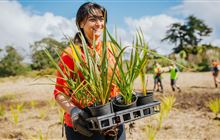Restoring Whangamarino Wetland
Introduction
Conservation in Whangamarino has focused on maintaining and enhancing wetland habitats, especially highly threatened bog and fern wetlandsOur vision: That one of New Zealand's largest wetlands remains an outstanding site for promoting the value of wetlands and species conservation, especially Australasian bittern/matuku-hūrepo.
Whangamarino wetland is a vital centre for native biodiversity and provides important ecosystem services. However, drainage of the wetland to create farmland and modification of waterways for flood control has damaged the health of the wetland and its inhabitants. Introduced species of flora and fauna have also made their mark, outcompeting or preying on native species and altering fragile habitats.
Work in Whangamarino has focused on maintaining and enhancing wetland habitats, especially highly threatened bog and fern wetlands. Habitat enhancement, weed control and predator trapping all help protect the rich biodiversity of the wetlands. Monitoring water levels and quality has helped build knowledge about wetland systems and how human land use affects these systems.
Key projects
Australasian bittern/matuku-hūrepo recovery
Programme objective: Enhance species diversity and protect threatened species
Site target: Population of Australasian bittern/matuku-hūrepo is increasing
Whangamarino is an important breeding site for the nationally critical bittern. Male bitterns attract females by making a loud booming sound, so in September we set up vocal monitors to assess numbers of male bittern in the wetland. We are also improving their habitat by controlling weeds and encouraging native habitat for their nest sites. Bitterns hunt by sight, so we need to improve the water clarity and quality for fish and eels.
Corybas carsei (swamp helmet orchid)
Programme objective: Enhance species diversity and protect threatened species
Site target: Population of Corybas carsei is increasing and self-sustaining
Whangamarino is the only known site in the world where the critically endangered swamp helmet orchid is found. There is evidence that Corybas carsei benefits from fire, as the disturbance and the boost of nutrients from the ash encourages growth. We undertake controlled burning and monitor the effects on the orchid's growth.
Weed control
Programme objective: Protect or restore ecosystem condition
Site targets: Grey willow reduced by >300 ha; Alligator weed and yellow-flag iris <1% at monitored sites
We are aiming to control and eradicate weeds like yellow flag iris, alligator weed and grey willow. These plants are often visible from the air, so we can survey the whole wetland from a helicopter to find where they are most common. We aerially spray willow at the beginning of summer when it has lots of foliage. The team will wade out into the swamp to tackle other weeds like pampas, blackberry and Glyceria.
Wetland forest restoration
Programme objective: Enhance species diversity and protect threatened species
Site target: Restoration of >20 ha to wetland forest
Kopuku Block is our main site of swamp forest restoration and has been planted with native trees, shrubs, Carex and flax. Bittern and dabchicks have been spotted enjoying the enhanced habitat. A trial is underway to determine whether directly sowing kahikatea seeds into soil could be an economical solution to mass planting.
Restoring water levels
Programme objective: Maintain or enhance water regime and water quality
Site target: Weir effectively maintains wetland water levels >3.0m RL.
A weir DOC and Fish & Game installed on the Whangamarino River is vital for maintaining water levels and keeping the wetlands productive. Prior to the weir installation, water levels had declined due to changes in catchment management, reducing habitat for bittern, waterfowl and wetland plants. We regularly undertake maintenance and monitoring to ensure the weir is functioning as designed.
Report cards
Brief snapshots of what we've achieved so far:
- Whangamarino –Australasian bittern/matuku-hūrepo 2017 (PDF, 1,110K)
- Whangamarino – Corybas carsei 2019 (PDF, 3,337K)
- Whangamarino – Phosphorus 2019 (PDF, 4,005K)
Science publications
- Eco-hydrology of Whangamarino wetland on the Wiley website
- Monitoring feral cats, ferrets and rodents in wetlands on the Taylor & Francis website
- Sediment source analysis using the CSSI technique – Whangamarino Wetland (PDF, 1,278K)
- Herbicide (glyphosate) redirects wetland vegetation on the Wiley website
- Herbicide effects on aquatic invertebrates on the Taylor & Francis website
- The economic values of Whangamarino Wetland
Key partners
Working in partnership with organisations and communities to share knowledge is an intrinsic element of Arawai Kākāriki.
Key partners involved with Whangamarino include:
- National Wetland Trust
- Auckland/Waikato Fish and Game Council
- Environment Waikato
- Waikato District Council
- University of Waikato
- NIWA
- Local landowners and duck hunters
Get involved
There are a number of things you can do to help.
Fishers can help by catching carp and catfish. Both species must killed upon capture – it is illegal to release them.
Organised groups can get involved in planting native trees and shrubs, and can run pest control programmes to protect bird populations.




